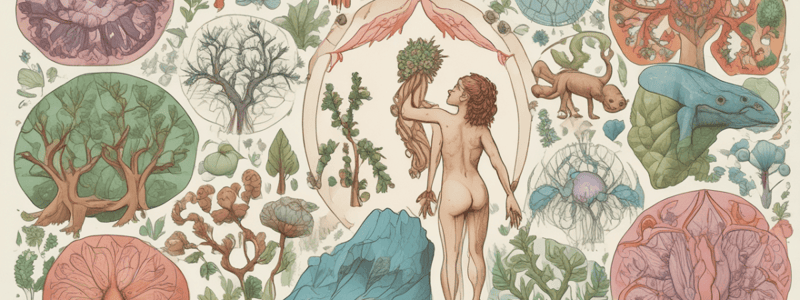Podcast
Questions and Answers
What is the primary purpose of the provided text?
What is the primary purpose of the provided text?
- To provide educational resources for literacy (correct)
- To explore the concept of gestation periods in animals
- To compare different animal species
- To discuss the importance of milk in animal development
What is the primary function of a mother's milk?
What is the primary function of a mother's milk?
- To provide nutrition to young animals (correct)
- To aid in animal reproduction
- To help animals grow stronger
- To protect animals from diseases
What type of animals are carnivores?
What type of animals are carnivores?
- Meat-eating animals (correct)
- Herbivorous animals
- Omnivorous animals
- Plant-eating animals
Which type of animal has the longest gestation period?
Which type of animal has the longest gestation period?
What is the juvenile stage of an animal?
What is the juvenile stage of an animal?
What is the common ancestor of all species on Earth?
What is the common ancestor of all species on Earth?
What is the primary source of nutrition for young mammals?
What is the primary source of nutrition for young mammals?
What is the term for a group of animals that eat meat?
What is the term for a group of animals that eat meat?
What is the term for the process by which animals develop from birth to adulthood?
What is the term for the process by which animals develop from birth to adulthood?
Flashcards are hidden until you start studying
Study Notes
Life Cycle Comparison
- All species on Earth have descended from the same simple organism and have evolved differently along the tree of life.
- The differences between species can be seen in their life cycles, including reproduction, lifespan, and development.
Reproduction
- Mammals produce live young, while insects, birds, and amphibians lay eggs.
- The gestation period for mammals ranges from 12 days to 95 weeks.
Lifespan
- The shortest-lived species are mayflies, which can live from 5 minutes to 24 hours.
- The longest-lived species are bowhead whales, which can live up to 200 years.
- Other species with notable lifespans include the termite queen (50 years), Laysan albatross (47 years), and cave salamanders (100 years).
Development
- Mammals are born fully formed, while insects and amphibians undergo metamorphosis from larvae to adult.
- Birds are also born fully formed, but may take time to develop fully.
Parenting
- Mammals nurture their young for varying periods, from a few weeks to many years.
- Insects do not provide parental care, while birds and amphibians care for their young for a short period.
Diet
- The diet of young mammals is the same as their mothers' milk, while young insects and amphibians have different diets than their adults.
- Tadpoles, the young of amphibians, eat plants, whereas adult amphibians are carnivores.
Life Cycle Comparison
- All species on Earth have descended from the same simple organism and have evolved differently along the tree of life.
- The differences between species can be seen in their life cycles, including reproduction, lifespan, and development.
Reproduction
- Mammals produce live young, while insects, birds, and amphibians lay eggs.
- The gestation period for mammals ranges from 12 days to 95 weeks.
Lifespan
- The shortest-lived species are mayflies, which can live from 5 minutes to 24 hours.
- The longest-lived species are bowhead whales, which can live up to 200 years.
- Other species with notable lifespans include the termite queen (50 years), Laysan albatross (47 years), and cave salamanders (100 years).
Development
- Mammals are born fully formed, while insects and amphibians undergo metamorphosis from larvae to adult.
- Birds are also born fully formed, but may take time to develop fully.
Parenting
- Mammals nurture their young for varying periods, from a few weeks to many years.
- Insects do not provide parental care, while birds and amphibians care for their young for a short period.
Diet
- The diet of young mammals is the same as their mothers' milk, while young insects and amphibians have different diets than their adults.
- Tadpoles, the young of amphibians, eat plants, whereas adult amphibians are carnivores.
Life Cycle Comparison
- All species on Earth have descended from the same simple organism and have evolved differently along the tree of life.
- The differences between species can be seen in their life cycles, including reproduction, lifespan, and development.
Reproduction
- Mammals produce live young, while insects, birds, and amphibians lay eggs.
- The gestation period for mammals ranges from 12 days to 95 weeks.
Lifespan
- The shortest-lived species are mayflies, which can live from 5 minutes to 24 hours.
- The longest-lived species are bowhead whales, which can live up to 200 years.
- Other species with notable lifespans include the termite queen (50 years), Laysan albatross (47 years), and cave salamanders (100 years).
Development
- Mammals are born fully formed, while insects and amphibians undergo metamorphosis from larvae to adult.
- Birds are also born fully formed, but may take time to develop fully.
Parenting
- Mammals nurture their young for varying periods, from a few weeks to many years.
- Insects do not provide parental care, while birds and amphibians care for their young for a short period.
Diet
- The diet of young mammals is the same as their mothers' milk, while young insects and amphibians have different diets than their adults.
- Tadpoles, the young of amphibians, eat plants, whereas adult amphibians are carnivores.
Studying That Suits You
Use AI to generate personalized quizzes and flashcards to suit your learning preferences.




